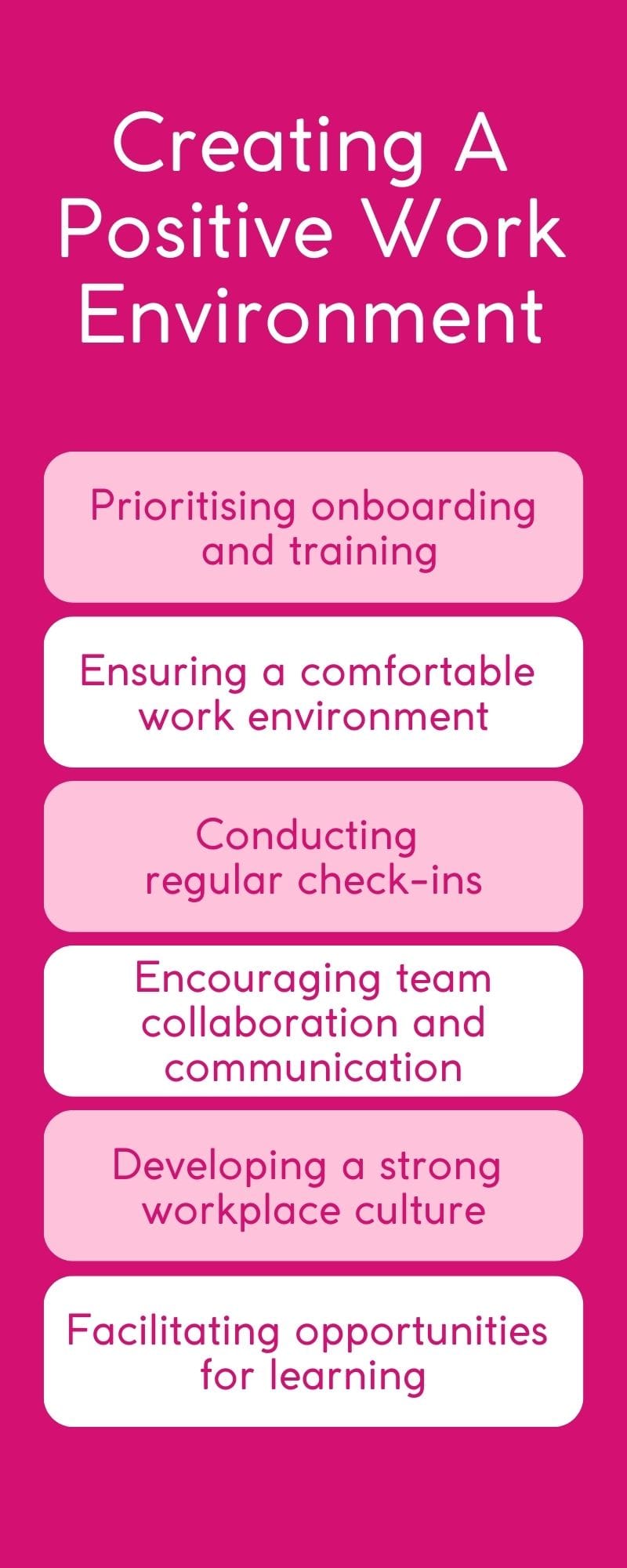In today's competitive business landscape, attracting and retaining top talent is crucial for a company's success. One of the key factors that can make a significant difference in achieving this goal is fostering a positive work environment. A positive work environment goes beyond providing competitive salaries and benefits; it involves creating a culture where employees feel valued, supported, and motivated to give their best.
In this comprehensive guide, we will explore the various aspects of creating a positive work environment and its importance in recruitment and employee retention. By implementing the strategies discussed here, businesses can streamline their recruitment process and cultivate a workplace that attracts and retains the right talent.
Understanding a Positive Work Environment
A positive work environment is one where employees feel engaged, empowered, and appreciated. It is an environment where collaboration, open communication, and mutual respect flourish. A positive work environment is not about eliminating all challenges; rather, it focuses on fostering a culture where challenges are addressed constructively and employees feel supported in overcoming them. Such an environment encourages innovation, boosts productivity, and promotes a sense of loyalty and commitment among employees.
The Importance of a Positive Work Environment
Creating a positive work environment is not just a nice-to-have perk; it is a strategic move that can yield numerous benefits for businesses. A positive work environment directly impacts employee satisfaction and well-being, leading to increased productivity and reduced turnover rates. Happy employees are more likely to go the extra mile for their organisation, resulting in higher job satisfaction and better overall performance. Additionally, a positive work environment enhances a company's reputation, making it an attractive destination for top talent seeking a supportive and fulfilling workplace.
Creating a Positive Work Environment

Prioritising Onboarding and Training
The journey to a positive work environment begins with a strong onboarding and training program. An effective onboarding process helps new employees assimilate into the organisation's culture, understand their roles, and build connections with their colleagues. Comprehensive training ensures that employees have the necessary skills and knowledge to perform their tasks confidently, contributing to their job satisfaction and overall engagement.
Ensuring a Comfortable Work Environment
A comfortable work environment is conducive to productivity and well-being. Ergonomic workstations, ample natural light, appropriate temperature control, and noise reduction measures all contribute to a more comfortable workspace. When employees feel physically comfortable, they can focus on their work and perform at their best.
Conducting Regular Check-ins
Regular check-ins between managers and employees are vital for building strong relationships and fostering a sense of support and trust. These one-on-one discussions provide an opportunity to address concerns, offer feedback, and recognise achievements. Managers who actively engage in check-ins show that they value their employees' well-being and success.
Encouraging Team Collaboration and Communication
Collaboration and open communication are cornerstones of a positive work environment. Encouraging teamwork and providing platforms for effective communication, such as team meetings, project management tools, and internal messaging systems, can boost productivity, creativity, and camaraderie among employees.
Developing a Strong Workplace Culture
Workplace culture sets the tone for an organisation's values, beliefs, and behaviours. A strong and positive workplace culture aligns employees with a common purpose, fosters a sense of belonging, and supports professional growth. Company values and cultural norms should be clearly defined and consistently reinforced to create a cohesive and purpose-driven work environment.
Facilitating Opportunities for Learning
A commitment to continuous learning not only improves employee skills but also signals a company's investment in its workforce. Providing opportunities for training, workshops, seminars, and skill development programs demonstrates that the organisation values employee growth and supports their long-term career aspirations.
The Role of Positive Attitudes in the Workplace
In a positive work environment, attitudes play a significant role in shaping the overall culture. Positive attitudes influence employee interactions, motivation, and problem-solving abilities. When employees maintain positive attitudes, even during challenging times, it can contribute to a healthier work atmosphere and encourage others to adopt the same mindset. Leaders should lead by example and foster a positive attitude that permeates throughout the organisation.
The Power of Excitement and Enthusiasm
Excitement and enthusiasm are contagious. When employees are genuinely excited about their work and the organisation's goals, it can create a positive ripple effect throughout the workplace. Encouraging employees to share their passions and ideas, recognising and celebrating achievements, and providing opportunities for personal growth can fuel enthusiasm and bolster employee morale.
The Impact of High Job Satisfaction
Job satisfaction is directly linked to employee engagement, retention, and productivity. When employees feel satisfied with their work, they are more likely to stay committed to the organisation and perform at their best. To improve job satisfaction, companies should seek regular feedback from employees, address concerns promptly, and recognise and reward achievements.
The Importance of Positive, Effective Communication
Open and transparent communication is the backbone of a positive work environment. When employees feel heard and respected, they are more likely to voice their ideas and concerns openly. Organisations should encourage a culture of open dialogue, where feedback is welcomed, and constructive criticism is embraced as an opportunity for growth.
The Benefits of Cooperation, Support, and Empowerment
In a positive work environment, employees support each other's success and work together as a cohesive unit. When teams collaborate effectively, individuals feel empowered and motivated to contribute their best efforts. Encouraging a culture of cooperation, empathy, and support can lead to a more inclusive and harmonious workplace.
The Value of a Sense of Humour in the Workplace
A sense of humour can be a powerful tool to alleviate stress, promote camaraderie, and improve overall workplace dynamics. Appropriate humour can create a relaxed and enjoyable atmosphere, boosting team morale and enhancing employee well-being. However, it's essential to maintain a respectful and inclusive approach to humour, avoiding any offensive or hurtful comments.
The Need for Flexibility in the Workplace
Flexibility is highly valued by modern employees. Offering flexible work arrangements, such as remote work options or flexible hours, can significantly improve work-life balance and job satisfaction. A flexible work environment demonstrates trust in employees' abilities to manage their responsibilities effectively, leading to increased loyalty and productivity.
The Importance of Work-Life Balance
Maintaining a healthy work-life balance is crucial for employee well-being and long-term job satisfaction. Organisations that prioritise work-life balance through policies and practices not only attract top talent but also retain employees in the long run. Encouraging employees to take breaks, utilise vacation time, and set boundaries between work and personal life can contribute to a more positive and productive work environment.
The Commitment to Employee Development
Investing in employee development is an investment in the company's future. Offering opportunities for skill development, career advancement, and leadership training can empower employees and increase their sense of loyalty and commitment to the organisation. Moreover, it fosters a culture of continuous learning and improvement.
The Freedom to be Creative in the Workplace
Encouraging creativity and innovation empowers employees to think outside the box and contribute fresh ideas. A positive work environment welcomes creativity and values diverse perspectives, fostering a culture where employees feel comfortable sharing their innovative ideas without fear of judgement.
Building a Culture of Teamwork

A culture of teamwork and collaboration strengthens relationships between employees and enhances problem-solving capabilities. When employees feel like part of a supportive team, they are more likely to share knowledge, seek assistance, and work towards collective goals. Organisations should actively encourage teamwork and recognise collaborative efforts.
A positive work environment is a catalyst for attracting and retaining top talent in today's competitive business world.
By prioritising onboarding and training, ensuring a comfortable workspace, promoting regular check-ins, encouraging teamwork and communication, and developing a strong workplace culture, businesses can create an environment where employees thrive. Additionally, fostering positive attitudes, excitement, and enthusiasm, promoting job satisfaction, effective communication, cooperation, and empowerment, and valuing humour, flexibility, work-life balance, employee development, and creativity all contribute to a successful and positive work environment.
In the pursuit of a positive work environment, businesses can achieve higher levels of employee satisfaction, improved productivity, and decreased turnover rates. Embracing these proven strategies not only aligns with our vision and values but also reflects the commitment to help businesses streamline their recruitment process and create workplaces that attract and retain top talent. By prioritising a positive work environment, organisations can lay the foundation for sustained success and growth in the long run.

